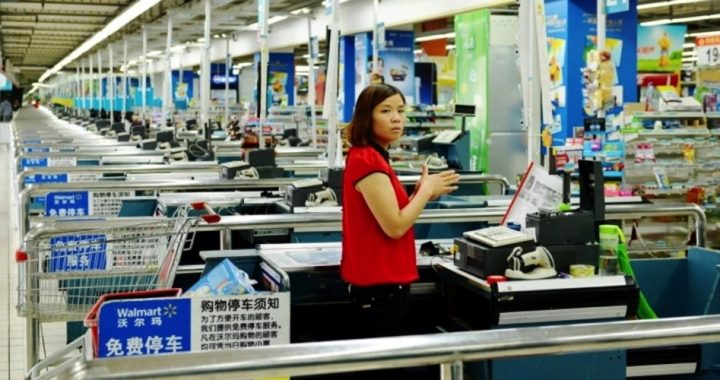
The latest numbers out of China no longer mask its economic decline. Chinese industrial production “slowed at its sharpest rate in the first two months of the year since the global financial crisis” shouted the Financial Times on Wednesday.
Wang Tao, UBS’ chief economist on the Chinese economy, was dour: “Today’s disappointing data release highlights just how quickly domestic demand is deteriorating as the ongoing [real estate] downturn continues to spread its negative impact through the economy.”
In China that impact is huge, representing more than 20 percent of the country’s total economic output. From the mining of iron ore to the employing of finish carpenters, the ripple effect of any decline in housing is immense. That decline is breathtaking: In just the first two months of 2015, housing sales have dropped by one-sixth — that’s 16 percent! — compared to a year ago. And that follows a 7.6 percent decline in December. This is the worst decline in the real estate market since the start of the global financial crisis, and likely signals the final victory of supply over demand that the Chinese government has stoked for decades.
Efforts to thwart the decline are failing as well. The country’s central bank has reduced interest rates to a minuscule 0.25 percent while loosening loan requirements on new mortgages. For years the yuan has been perceived as a poor place to store cash, and so citizens have been buying up new apartments as the new “store of value” — some 50 million of them. They remain unoccupied because the minute a family moves in, the secondary market, which the government can’t control, takes over, forcing resale prices down significantly. Because much of that new construction is debt-financed, either directly or through the now well-known “shadow” banking system, a sharp decline in prices pushes borrowers into default.
When China was boot-strapping itself from its Third World position as a poor agrarian society, it relied heavily on strong exports based on low wages. Rapid industrialization followed, and records have been set as the Chinese economy roared ahead at double-digit growth rates for the last two decades.
Now, however, the enormous market correction taking place is being resisted for many reasons, most of them political, by implementing standard Keynesian remedies: borrow and spend. If that doesn’t work, borrow and spend some more. Even if the spending is on such wasteful projects as building highways without cars, cities without inhabitants, and airports without planes. It’s being justified, according to Matt O’Brien, writing in the Washington Post last week, by the government making “the things it needed to be a rich country — new houses, subway lines, and roads — all sleek, all modern, and all paid for with borrowed money.”
The country’s debt-to-GDP ratio was an astronomical 153 percent just seven years ago. Today it has nearly doubled to a nose-bleeding 282 percent.
Interest charges on that debt is now soaking up more than 13 percent of the country’s GDP, with predictable consequences. Rich Chinese are exiting the country as fast as they can; companies unable to move are cooking their books in order to move cash reserves offshore; and high-end retailers and luxury automakers there are suffering massive declines in sales.
With real estate imploding, Chinese citizens have found another place to “invest”: their equivalent of Wall Street — the Shanghai Index. Just since last summer, stocks have exploded, pushing that index to levels not seen in a decade. As O’Brien caustically noted:
The Shanghai index has … been on a tear the last six months, up 50 percent in that time.
Why?
Well, it’s not earnings. Those are down.
No. It’s the debt. Investors have become so exuberant … that they aren’t just throwing their own money into the stock market, but borrowed money, too. Margin accounts … more than doubled in 2014.
Aside from the increasingly obvious failure of Keynesian economic “solutions” to try to get the Chinese economy back on track, there’s another obstacle: The numbers coming out of China aren’t real. Anne Stevenson-Yang is the director of research for J Capital, which does fundamental economic analysis on China for its customers worldwide. In an interview at Barron’s, Stevenson-Yang was blunt:
People are crazy if they believe any government statistics which, of course, are largely fabricated….
The actual Chinese GDP is probably a third lower than is officially reported….
I’d be shocked if China is currently growing at a rate above, say, 4%.
Here’s the kicker: That interview at Barron’s took place more than a year ago, in December, 2014!
The economic crash in China is rapidly approaching. Chinese corporations have taken on almost $2 trillion in debt. Said Stevenson-Yang, “If defaults start to cascade through the economy … it’s here that a credit crisis could start.”
Some lessons in life need to be learned over and over again, it seems. Chinese experimentation with Keynesian “solutions” to Keynesian-induced “problems” will confirm them to be wrong-headed once again. As one commentator suggested, the Chinese crash could be “1929 all over again, with Chinese characteristics.” Same lessons, different place.
Photo of almost deserted Chinese Walmart: AP Images
A graduate of an Ivy League school and a former investment advisor, Bob is a regular contributor to The New American magazine and blogs frequently at www.LightFromTheRight.com, primarily on economics and politics.



